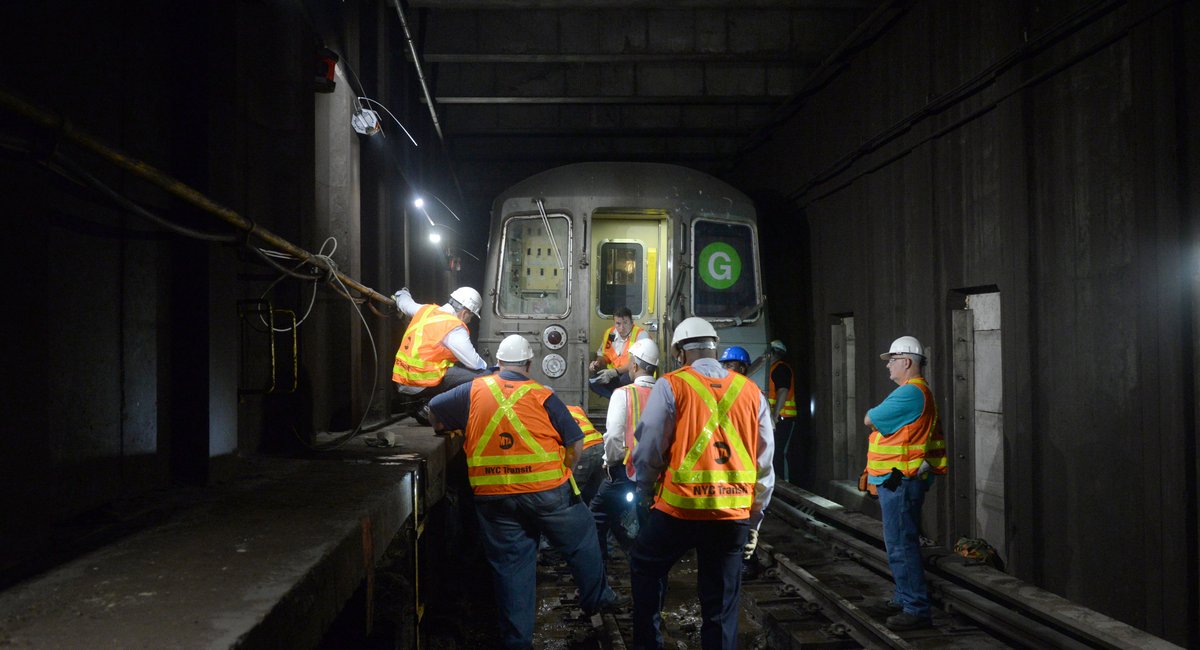This column originally appeared in On The Way, a weekly newsletter covering everything you need to know about NYC-area transportation.
Sign up to get the full version, which includes answers to reader questions, trivia, service changes and more, in your inbox every Thursday.
G train riders suffered a summer of pain from June into September, with entire sections of the line closed around the clock for construction and upgrades. Now, the line’s 160,000 daily riders are asking: “What exactly did we gain?”
For Sureni Weerasekera, 26, who lives in Bushwick and has a girlfriend in Clinton Hill, the disruptions gave her a better understanding of Brooklyn’s bus and bike share networks.
“I unintentionally entered into a long distance relationship with my girlfriend because of the G train,” said Weerasekera. “We were taking Citi Bikes, we were taking the bus, we were taking, I don’t know, carrier pigeons.”
When the line fully reopened after Labor Day, G train riders were met with 10 cleaner stations. Workers had scrubbed platforms, painted columns, replaced 9,495 wall tiles and converted 4,858 lights to LED lamps.
But commuters don’t see the bulk of the work done by the MTA — and New Yorkers won’t see its full benefits for several years.
The shutdown allowed crews to modernize the 90-year-old signal equipment that’s directed trains on the Crosstown Line since Franklin D. Roosevelt was in the White House. Thanks to the new infrastructure, the MTA will be able to run communications-based train control — or CBTC — on the line, allowing it to run trains more frequently and at faster speeds.
But MTA officials said that the new signal system won’t be switched on along the G line until at least 2027.
“It has been cleaner, but hopefully they have the operational money to keep it maintained,” frequent G train rider Chiquita Brujita said. “Sometimes you have to do work that is long-term work, so that’s not really up to us.
“You gotta make the sacrifices now if you want to see the seeds later,” she said. “You don’t eat the fruit the day you plant the seed.”
MTA Chair Janno Lieber touted the line’s closures as a success at this month’s board meeting.
“A project of this magnitude and complexity, a full shutdown, has never gone this smoothly before, it is safe to say,” Lieber said. “It set a new standard for all of our major projects going forward.”
Curious Commuter:
Have a question about subway cars (or literally anything else NYC-transit related)? Use this form to submit yours and we may answer it in a future newsletter! But note that Curious Commuter questions are exclusive for On The Way newsletter subscribers. Sign up for free here.
Question from Prince in the Bronx
Has anyone given any serious thought or come up with a serious plan of making the public buses free (since they are used for shorter trips) and maybe raising the cost of subway fares?
Answer
The thought of free bus service is a hot topic among New York City progressives — so much so that in 2023, state lawmakers passed a bill sponsored by Queens Assemblymember Zohran Mamdani that waived the fare on a bus route in each borough. That program expired at the end of August, and the MTA never liked the initiative. Transit officials said the free rides may have led to increased fare evasion on non-free bus routes. But making the entire bus system completely free would also require more subsidies: The MTA relies on hundreds of millions of fares every year to pay the drivers, mechanics and other staffers who make the bus system possible. Without that fare revenue, they’d need to turn to another source of cash — likely your tax dollars.
The latest NYC area transit headlines
- The NYPD last week released body-worn camera footage that shows police shooting four people on a Brownsville subway platform after officers chased an alleged fare evader and repeatedly told him to drop his knife. Read more.
- How does the city keep President Joe Biden safe during his visits to Manhattan? Part of it involves parking a bunch of sanitation department salt spreader trucks in front of his location. Read more.
- The MTA board on Wednesday unanimously signed off on the agency’s $65.4 billion five-year capital plan — though officials said they still need state lawmakers to find ways to cover at least $33 billion of the plan’s cost. Read more.
- After a brave MTA worker tasted the mysterious liquid pouring into the Queens-Midtown Tunnel earlier this month, the agency was able to determine that the leak was coming from the East River and not a burst water main. Read more.
- Transit officials said the recent crackdown on bus fare evasion has so far yielded modest results, with paid ridership on bus routes with added enforcement up 4.6% compared to the rest of the city’s bus network. Read more.
- The parks department has closed the Hudson River Greenway from 100th to 125th streets until spring of 2025 for necessary repair work. Read more.
- City data shows the NYPD issued 786 jaywalking summonses during the first six months of 2024 — and only 15% of them were given to white people. Read more.
- More than 100 cyclists gathered near the Brooklyn side of the Williamsburg Bridge last weekend for a street race with a $1,000 cash prize and a catch: Citi Bikes only. Read more.
